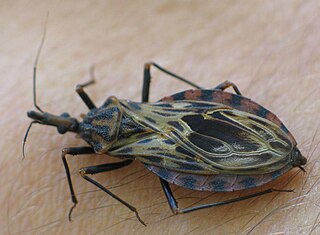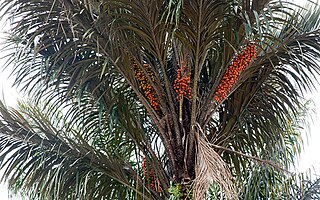
Chagas disease, also known as American trypanosomiasis, is a tropical parasitic disease caused by Trypanosoma cruzi. It is spread mostly by insects in the subfamily Triatominae, known as "kissing bugs". The symptoms change over the course of the infection. In the early stage, symptoms are typically either not present or mild, and may include fever, swollen lymph nodes, headaches, or swelling at the site of the bite. After four to eight weeks, untreated individuals enter the chronic phase of disease, which in most cases does not result in further symptoms. Up to 45% of people with chronic infections develop heart disease 10–30 years after the initial illness, which can lead to heart failure. Digestive complications, including an enlarged esophagus or an enlarged colon, may also occur in up to 21% of people, and up to 10% of people may experience nerve damage.

Carl Friedrich Philipp von Martius was a German botanist and explorer.

The members of the Triatominae, a subfamily of the Reduviidae, are also known as conenose bugs, kissing bugs, or vampire bugs. Other local names for them used in the Americas include barbeiros, vinchucas, pitos, chipos and chinches. Most of the 130 or more species of this subfamily feed on vertebrate blood; a very few species feed on invertebrates. They are mainly found and widespread in the Americas, with a few species present in Asia and Africa. These bugs usually share shelter with nesting vertebrates, from which they suck blood. In areas where Chagas disease occurs, all triatomine species are potential vectors of the Chagas disease parasite Trypanosoma cruzi, but only those species that are well adapted to living with humans are considered important vectors. Also, proteins released from their bites have been known to induce anaphylaxis in sensitive and sensitized individuals.

Rhodnius is a genus of assassin bugs in the subfamily Triatominae, and is an important vector in the spread of Chagas disease. The Rhodnius species were important models for Sir Vincent Wigglesworth's studies of insect physiology, specifically growth and development.

Panstrogylus geniculatus is a blood-sucking sylvatic insect noted as a putative vector of minor importance in the transmission of Trypanosoma cruzi to humans; this is a parasite, which causes Chagas disease. The insect is described as sylvatic; subsisting primarily in humid forests, and is also known to inhabit vertebrate nesting places such as those of the armadillo, and is also involved in enzootic transmission of T. cruzi to those species. It has wide distribution throughout 16 Latin American countries.

Rhodnius prolixus is the principal triatomine vector of the Chagas parasite due to both its sylvatic and domestic populations in northern South America as well as to its exclusively domestic populations in Central America. It has a wide range of ecotopes, mainly savanna and foothills with an altitude of between 500 to 1,500 metres above sea level and temperatures of 16 to 28 °C. Sylvatic R. prolixus, as virtually all Rhodnius spp., is primarily associated with palm tree habitats and has a wide range of hosts including birds, rodents, marsupials, sloths, and reptiles.

Triatoma nigromaculata is a sylvatic species of insect usually found in hollow trees, in vertebrate nests on trees and occasionally in human dwellings. It usually lives in relatively humid forests at high altitudes on mountain regions and foot hills. As all members of the subfamily Triatominae, T. nigromaculata is a blood-sucking bug and a potential vector of Chagas disease. This species is distributed mainly in Venezuela, but some specimens have also been found in Perú and Colombia (Cauca).

João Barbosa Rodrigues was considered one of Brazil's greatest botanists, known especially for his work on orchids and palms. For nearly two decades he was director of the Botanic Garden of Rio de Janeiro. Something of a polymath, he was a prolific botanical artist who also made contributions to his country's ethnography, geography, linguistics, zoology, and literature. The standard author abbreviation Barb.Rodr. is used to indicate this person as the author when citing a botanical name.
Astronium fraxinifolium is a timber tree, which is native to Amazon Rainforest, Atlantic Forest, Caatinga, and Cerrado vegetation in Brazil. Common names include kingwood, locustwood, tigerwood, and zebrawood. It is known in Portuguese as Gonçalo-alves. This plant is cited in Flora Brasiliensis by Carl Friedrich Philipp von Martius. It is also used to make hardwood such as tigerwood.

Astrocaryum vulgare is a very spiny palm native to the Guianas and the Amazon. It is species which has greatly benefited from deforestation, as it cannot grow in undisturbed rainforest. In Brazil it is considered typical of Pará state in the north of the lower Amazon. This plant has edible fruit.

Oenocarpus bacaba is an economically important monoecious fruiting palm native to South America and the Amazon Rainforest, which has edible fruits. This plant is cited in Flora Brasiliensis by Carl Friedrich Philipp von Martius. It can reach up to 20–25 metres tall and 15–25 cm in diameter. It grows in well-drained sandy soils of the Amazon basin.

Piassava, also piaçava, piaçaba, piasaba, pissaba, piassaba, and piaçá, is a fibrous product of Brazilian palm species Attalea funifera and Leopoldinia piassaba. It is often used in making brooms and for other purposes.
Triatoma melanica is a hematophagous insect, a Chagas disease vector, included in the Triatominae group. It occurs in the north of Minas Gerais state, Brazil, and is found almost exclusively in silvatic environment. However, sporadically it may also invade houses. T. melanica was originally described as Triatoma brasiliensis melanica Neiva & Lent, 1941. Recently, it was redescribed with a new specific status, due to its distinct morphology, genetics, and biogeographic characteristics.

Triatoma brasiliensis is now considered the most important Chagas disease vector in the semiarid areas of northeastern Brazil. T. brasiliensis occurs in 12 Brazilian states, including Maranhão, Piauí, Ceará, Rio Grande do Norte, and Paraíba.
Triatoma juazeirensis is an assassin bug, a Chagas disease vector which occurs in the State of Bahia, Brazil. It is found in natural and artificial environments infesting mainly the peridomiciliary areas but it may also colonize the intradomicile. T. juazeirensis can be distinguished from the other members of the brasiliensis complex by its entire dark pronotum and legs.
Aphandra is a monotypic genus of flowering plant in the palm family native to the Amazon rainforest vegetation in South America. Its only species is Aphandra natalia, sometimes called mastodon palm or fiber palm, and is used by indigenous peoples in the construction of brooms and other products. This plant is commercially exploited for its edible fruits, and for its leaf sheath and petiole fibers. This fiber is almost equal to the fiber extracted from Attalea funifera and Leopoldinia piassaba, which is called piassava.
Guaporé Biological Reserve (Portuguese: Reserva Biológica do Guaporé is a biological reserve in the state of Rondônia, Brazil, on the border with Bolivia.

Leopoldinia is a mostly monoecious genus of flowering plant in the palm family from northern South America, where they are known as jará palm or pissava palm. The two known species are commercially important, especially L. piassaba, which yields sustenance and construction material. The genus is named for Maria Leopoldina, archduchess of Austria, and Brazilian empress.

Attalea phalerata is a species of palm tree known by the English common name urucuri palm, the Portuguese common name urucurizeiro, and the Spanish common name shapaja. Other common names include motacu and bacuri. It is native to Brazil, Bolivia, Paraguay, and Peru, where it grows along southern and western Amazonia. It is the most common palm tree on the Pantanal.











